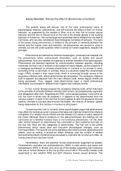Essay Question: Discuss the effect of pheromones on behavior
The present essay will discuss one of the most controversial areas of
psychological research, pheromones, and will examine the effect of them on human
behavior, as supported by the studies of Zhou et al on their link to human sexual
behavior and the one of Doucet et al on the role of the areolar glands in the sucking
behavior of newborns. The counterargument presented will be drafted from the field of
hormones, who are also considered major biological correlates of behavior. The topic
of the essay, being pheromones, is related to the principle of similarity between the
animal and the human brain and behavior, as pheromones are proved to exist in
animals, but are still under question when it comes to human organisms, despite that
principle.
Pheromones are defined as chemical messengers, produced and released into
the environment, which communicate information, such as fertility and sexual
attractiveness, from one member of a species to another member of the same species.
Pheromones are deemed important for communication between species, including
mammals, but their role in humans is still subject to heavy debate, as the existence of
a biological mechanism to process pheromones in humans is not proved to exist,
according to the current data. In animals, there is a structure called the vomeronasal
organ (VNO), located in their nasal cavity, which is connected through nerves to the
accessory olfactory bulb, where pheromones are processed. The accessory olfactory
bulb is adjacent but separate from the main olfactory bulb, where regular smells are
being processed. Thus, despite most pheromones have a smell, pheromonal
information is processed in different brain regions than ordinary smells.
In fact, human fetuses possess the accessory olfactory bulb, which links back
to the principle of similarity between animals and humans, but progressively regresses
and disappears after birth. Regarding the VNO, some people possess it and some do
not, but even to those who do possess it, it appears to be disconnected from the
nervous system. In spite of the fact that humans appear to lack the structures that are
used by animals to process pheromonal information, the chance of another system
being responsible for that function in humans is still present.
Concerning their role in humans, some psychologists argue that pheromones
may affect the menstrual cycle in groups of females and might be linked to the olfactory
recognition of a newborn by its mother and the release of a variety of odors, based on
the mood. Although there is evidence on the abovementioned, the findings are not
conclusive as to whether humans have or not functional pheromones. On the other
side, animal research on pheromones has concluded on their existence and also on
the fact that there are two categories of pheromones. The first one is the primer
pheromones which cause slow and long-term physiological changes, such as
hormonal effects. The second one is the signaling ones which provoke rapid behavioral
effects, such as mating. It should be noted, however, that the number of studies
demonstrating effects of pheromones are equal to ones who do not and up to date, no
human pheromone has been found.
Nonetheless, there are potential human pheromones supported by studies.
Characteristic examples are androstadienone (AND) in male semen and swear and
estratetraenol (EST) in female urine and one of the studies supporting their existence
and role on human behavior is the one by Zhou et al in 2014. The study includes a lab
experiment to test whether AND and EST influence human sexual behavior. The
© 2020 Orsalia Toutouza All Rights Reserved




